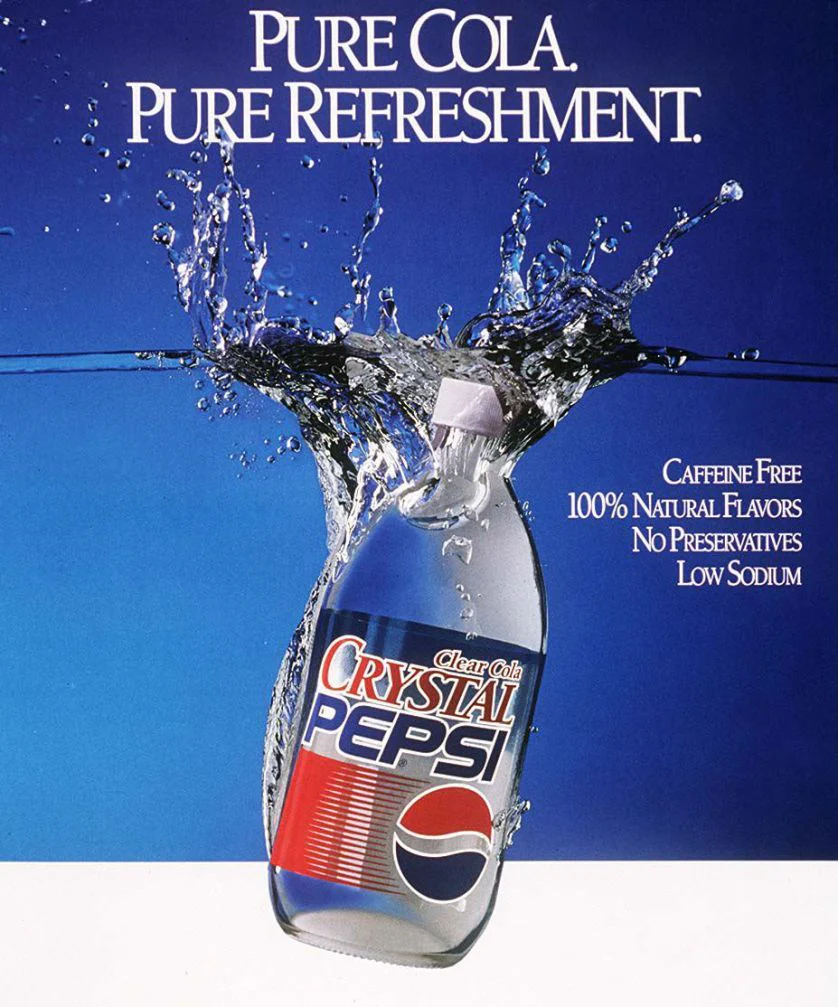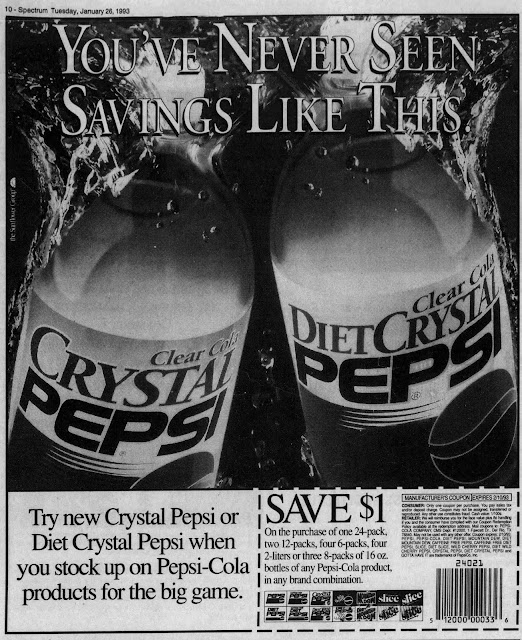Taste The 90s: Crystal Pepsi

The 1990s were a time for experimentation, innovation, and bold moves in the world of consumer culture. Few products epitomize the hope and promise of that particular era quite like Crystal Pepsi—a clear cola promising to be nothing like anything else on the shelf. As a kid in the decade, I was entranced by this newfangled stuff. One sweltering summer day sticks out in my mind when my mom and I were at Kmart. The heat haze shimmered outside, and there in front of me was this huge stack of Crystal Pepsi bottles. The clear crystalline liquid showed inside, very much like some kind of elixir from the future. I must have been ten years old, and I begged my mom to let me try it. She hesitated first, obviously faltering because she knew I was not much of a soda fan. But she realized this was more about curiosity than a need and with a smile, she relented.
I took that first sip, expecting something revelatory. In retrospect, Crystal Pepsi didn’t taste radically different from regular Pepsi—sweet, fizzy, familiar—but the experience itself felt extraordinary. But within a year, that mysterious clear soda had vanished from store shelves. Whatever became of this futuristic product? Let’s turn back time to the Crystal Pepsi story: its rise to great heights and its equally spectacular fall, leaving us a lesson or two.\

The early 1990s was a time when the world had been caught up in what marketing experts called the “Clear Craze.” Anything transparent, according to the commercials, meant it was pure. Ivory Soap released a clear version with its “99 and 44/100 percent pure” formula. Personal care brands launched dye-free, see-through gels. Even gadgets jumped on board with translucent casings that showed their inner mechanics. Into this atmosphere, PepsiCo saw an opening.
David Novak, then Executive Vice President of Marketing and Sales at PepsiCo, was inspired by the success of caffeine-free colas and clear drinks like Sprite and 7-Up. In his office one day, the idea struck him: “Why not make a Pepsi that’s both clear and caffeine-free?” Novak pitched the idea to Pepsi’s CEO, Roger Enrico, emphasizing that modern consumers wanted healthier, lighter options. Enrico gave him the green light.
Novak brought in Surinder Kumar, a renowned food scientist behind such successes as Nacho Cheese Doritos, to create the product. His goal was ambitious: a cola as clear as glass, with the same taste as regular Pepsi – no caramel color or caffeine allowed. But there was one tiny catch, says Kumar:. Colas were brown for a reason—the color helped protect the drink from light exposure, preventing it from developing off-flavors. Clear soda in a transparent bottle would be more susceptible to sunlight, potentially causing it to spoil. But Pepsi’s executives insisted that the transparency was non-negotiable. It had to be crystal clear.
Kumar and his team developed a proprietary blend of sugars, salts, and flavoring agents that could replicate the unique taste of Pepsi without the unique color of Pepsi. Well, they couldn’t have access to every little detail since the original Pepsi formula was protected, making this task even tougher.
Crystal Pepsi launched in test markets in April 1992, Boulder being one of them, Colorado gained immediate attention for itself. People lined up to try the enigmatic clear soda. Emboldened by this positive response, PepsiCo stepped up with an ambitious national rollout. Officially introduced during the Super Bowl in January 1993, the high-energy commercial set to Van Halen’s “Right Now” highlighted astronauts and athletes, along with a lot of dramatic visuals—positioning Crystal Pepsi as the drink of the future. The slogan proclaimed: “You’ve never seen a taste like this.”
For a moment, Crystal Pepsi was the coolest drink in town. It was on the news and parodied on Saturday Night Live; it filled vending machines and cafeterias across the nation. In its first year, it seized more than 1% of the US soft drink market and grossed somewhere near $474 million—something close to $1 billion in today’s terms.
But beneath the surface, hairline fractures were beginning to appear.
Despite its auspicious debut, Crystal Pepsi faced serious hurdles. First, there was the problem of flavor. Although Pepsi had attempted to duplicate its signature taste, consumers detected subtle differences. Many reported a strange aftertaste, while focus groups said it lacked enough of the signature “Pepsi punch.” One distributor warned Novak, “Everybody will try it. The problem is that nobody will retry it.”
But the main challenge came when Coca-Cola launched a rival product called Tab Clear. The move by no means was a normal competition. In the opinion of Coca-Cola’s Chief Marketing Officer, Sergio Zyman, Tab Clear was a “kamikaze” product designed to confuse the consumers and malign the reputation of clear sodas. Reinforcing the perception that clear colas are bland, medicinal or experimental, Tab Clear was marketed as a diet drink.
The last nail in the coffin came from an unexpected quarter-the sun. Stores normally showcased Crystal Pepsi in brightly exposed store windows or at gas station entrances. Just as Kumar had warned, it was subject to UV rays spoilage. There were instances of bottles of soda that either tasted like “shoe polish” or resulted in upset stomachs.
Crystal Pepsi’s cultural moment also became its downfall. In 1993, Saturday Night Live aired a parody commercial for “Crystal Gravy,” a clear, gelatinous meat sauce. The skit featured actors dunking fried chicken into a viscous, transparent liquid while splashing it across their faces. The absurdity of the sketch cemented Crystal Pepsi’s reputation as a strange novelty rather than a serious product.
By the end of 1993, PepsiCo decided to pull the product from the shelves. The last attempt at re-formulating it as a citrus-flavored soda called “Crystal by Pepsi” didn’t make it big. By early 1994, Crystal Pepsi was history.
Crystal Pepsi may not have survived very long, but it never left the public’s consciousness. In 2014, TIME magazine even included it on its list of the “10 Biggest Product Fails of All Time,” but the drink still had ardent fans. Online campaigns in 2015, including a viral video by YouTuber Kevin Strahle—aka “The L.A. Beast”— reignited calls for it to return. PepsiCo answered in 2016 with a limited re-release, and bottles flew off the shelves riding a wave of 1990s nostalgia.
To celebrate its 30th anniversary in 2022, PepsiCo ran a contest whereby the lucky winners got six bottles of the iconic drink. Even though Crystal Pepsi is not available for general purchase, it has maintained this interest in it, proving it to be an iconic drink.
The Crystal Pepsi journey is one of those times when marketing designs did not align with the execution of the product and that should serve as a wake-up call to those ambitious to embark on such adventures. Its creator, David Novak, said of Crystal Pepsi, “It was probably the best idea I’ve ever had and the most poorly executed,” later on. The rush to market and the disregard of some fundamental issues were the factors that eventually killed the product.
However, though that clear soda once danced in front of our eyes, it has not been forgotten. It speaks of the days when companies were not afraid to think big, even if that sometimes meant failing. At the same time, I have a vivid picture of my pre-adolescent self standing in line at Kmart, sweating, and saying my first words when I realized that I had my first Crystal Pepsi on a very hot day.